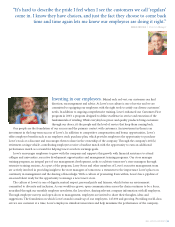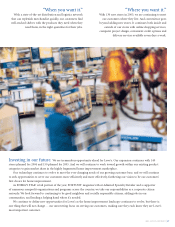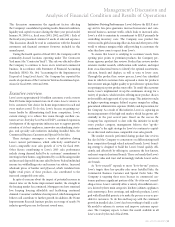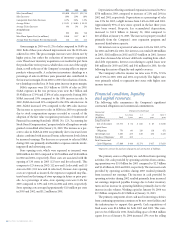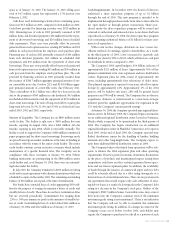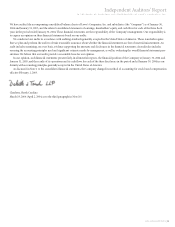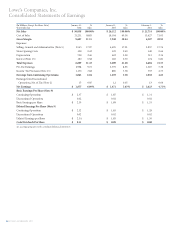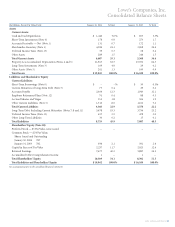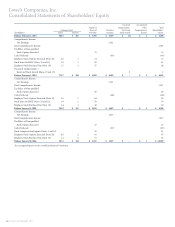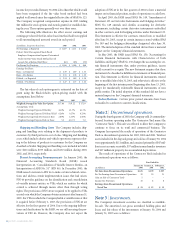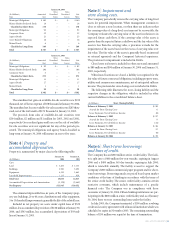Lowe's 2003 Annual Report Download - page 25
Download and view the complete annual report
Please find page 25 of the 2003 Lowe's annual report below. You can navigate through the pages in the report by either clicking on the pages listed below, or by using the keyword search tool below to find specific information within the annual report.
2003 ANNUAL REPORT 23
space as of January 31, 2003. The January 31, 2003 selling space
total of 94.7 million square feet represented a 17% increase over
February 1, 2002.
Cash flows used in financing activities from continuing opera-
tions were $17 million in 2003, compared to $64 million in 2002.
Cash flows provided by financing activities were $929 million in
2001. Financing uses of cash in 2003 primarily consisted of $87
million from cash dividend payments, $50 million from the repay-
ment of short-term borrowings and $29 million from scheduled
debt repayments. These uses were partially offset by proceeds
generated from stock option exercises totaling $97 million and $52
million in cash proceeds from the employee stock purchase plan.
Financing uses of cash in 2002 primarily consisted of $66 million
from cash dividend payments, $63 million in scheduled debt
repayments and $50 million from the repayment of short-term
borrowings. These uses were partially offset by proceeds generated
from stock option exercises totaling $65 million and $50 million in
cash proceeds from the employee stock purchase plan. The cash
provided by financing activities in 2001 primarily resulted from
the issuance of $580.7 million aggregate principal amount of sen-
ior convertible notes due October 2021 and $1.005 billion aggre-
gate principal amount of convertible notes due February 2021.
These cash inflows of $1.1 billion were offset by a decrease in cash
due to the payment of $60 million in cash dividends, $63 million
in scheduled debt maturities and the repayment of $150 million in
short-term borrowings. The ratio of long-term debt to equity plus
long-term debt was 26.3%, 31.0% and 35.9% as of the fiscal years
ended 2003, 2002 and 2001, respectively.
Sources of Liquidity The Company has an $800 million senior
credit facility. The facility is split into a $400 million five-year
tranche, expiring in August 2006, and a $400 million 365-day
tranche, expiring in July 2004, which is renewable annually. The
facility is used to support the Company’s $800 million commercial
paper program and for short-term borrowings. Borrowings made
are priced based upon market conditions at the time of funding in
accordance with the terms of the senior credit facility. The senior
credit facility contains certain restrictive covenants which include
maintenance of a specific financial ratio. The Company was in
compliance with those covenants at January 30, 2004. Fifteen
banking institutions are participating in the $800 million senior
credit facility and, as of January 30, 2004, there were no outstand-
ing loans under the facility.
In July 2003, the Company terminated a $100 million revolving
credit and security agreement with a financial institution which was
scheduled to expire in November 2003. The remaining outstanding
balance of $50 million was repaid at the time of termination.
Five banks have extended lines of credit aggregating $330 mil-
lion for the purpose of issuing documentary letters of credit and
standby letters of credit. These lines do not have termination dates
but are reviewed periodically. Commitment fees ranging from
.25% to .50% per annum are paid on the amounts of standby let-
ters of credit. Outstanding letters of credit totaled $161 million as
of January 30, 2004 and $122 million as of January 31, 2003.
Cash Requirements In December 2003, the Board of Directors
authorized a share repurchase program of up to $1 billion
through the end of 2005. This new program is intended to be
implemented through purchases made from time to time either in
the open market or through private transactions. Shares pur-
chased under the share repurchase program will be retired and
returned to authorized and unissued status. As no shares had been
repurchased as of January 30, 2004, the share repurchase program
had a remaining authorized balance of $1 billion for future com-
mon stock repurchases.
With recent tax law changes, dividends are now a more tax-
efficient method of returning capital to shareholders. As a result,
in the third quarter of 2003, Lowe’s increased its quarterly cash
dividend per share by 20% to $0.03, which will increase cash paid
for dividends in 2004 as compared to 2003.
The Company’s 2004 capital budget is $3.4 billion, inclusive of
approximately $321 million of leases. Approximately 76% of this
planned commitment is for store expansion and new distribution
centers. Expansion plans for 2004 consist of approximately 140
stores, including approximately four relocations of older stores.
This planned expansion is expected to increase sales floor square
footage by approximately 14%. Approximately 2% of the 2004
projects will be build-to-suit leases, 28% will be ground leased
properties and 70% will be owned. The Company does not foresee
acquisitions, domestic or international, as a near-term strategic
initiative given the significant opportunities for expansion in the
U.S. with the Company’s current growth strategy.
At January 30, 2004, the Company operated nine regional distri-
bution centers. In February 2003, the Company began construction
on an additional regional distribution center located in Poinciana,
Florida, which is expected to be operational in the third quarter of
2004. The Company has begun construction on an additional
regional distribution center in Plainfield, Connecticut, to be open in
fiscal 2005. At the end of fiscal 2003, the Company operated nine
flatbed distribution centers for the handling of lumber, building
materials and other long-length items. The Company expects to
open three additional flatbed distribution centers in 2004.
The Company believes that funds from operations will be ade-
quate to finance the 2004 expansion plan and other operating
requirements. However, general economic downturns, fluctuations
in the prices of products and unanticipated impact arising from
competition could have an effect on funds generated from opera-
tions and our future expansion plans. In addition, the availability
of funds through the issuance of commercial paper and new debt
could be adversely affected due to a debt rating downgrade or a
deterioration of certain financial ratios. There are no provisions in
any agreements that would require early cash settlement of exist-
ing debt or leases as a result of a downgrade in the Company’s debt
rating or a decrease in the Company’s stock price. Holders of the
Company’s $580.7 million Senior Convertible notes may convert
their notes into the Company’s common stock if the minimum
investment grade rating is not maintained. There is no indication
that the Company will not be able to maintain this minimum
investment grade rating. In addition, if a change in control of the
Company occurs on or before October 2006, each holder may
require the Company to purchase for cash all or a portion of such


